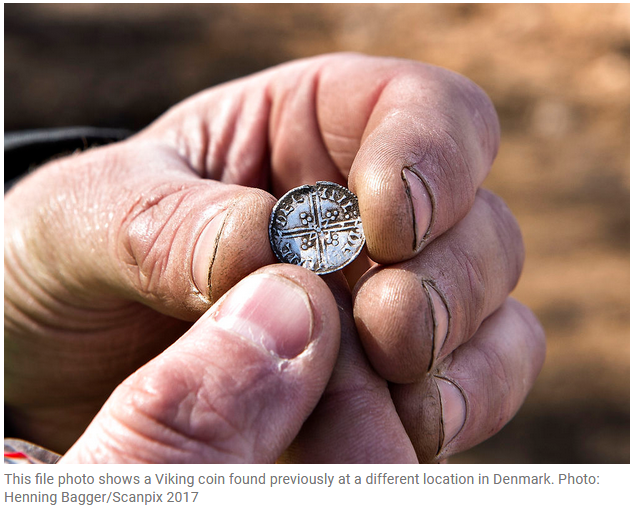Vikinghi. Scoperto un tesoro di 252 monete di argento del nono secolo.
Giuseppe Sandro Mela.
2019-03-07.

«Ribe (in tedesco Ripen) è la città più antica della Danimarca. Situata nella penisola dello Jutland, è inglobata nel comune di Esbjerg nella regione della Danimarca meridionale (Syddanmark); in precedenza, fino al 1º gennaio 2007 è stata capoluogo dell’omonima contea.
Le origini della cittadina risalgono agli anni 704-710, tempo della costruzione dei primi insediamenti.
Il nome Ribe deriverebbe dal danese antico (contaminato dal latino) ripa, cioè riva o sponda (nei documenti del XIV sec. è nominata come “Portus Ripeis”). L’insediamento iniziale consisteva di una settantina di case, più elevate nella parte centrale e attraversate da un canale. Il Ribe scorre attraverso il villaggio, crea paludi e sfocia a Vadehavet presso Kammerslusen.
Nell’860 l’arcivescovo di Brema-Amburgo, Oscar di Brema, nell’iniziare la “missione di riportare il cristianesimo al Nord”, chiese al re di Danimarca, che la prima cattedrale scandinava fosse costruita a Ribe. La richiesta non era casuale, dal momento che Ribe all’epoca era già una delle città commerciali più importanti in Scandinavia. Tuttavia la presenza di un vescovo, e quindi di una cattedrale, può essere confermata a Ribe solo dall’anno 948.» [Fonte]
* * * * * * *
Nel nono secolo Vikinghi a nord, Ungari ad est e saraceni a sud accerchiavano il nascente occidente: erano razziatori di incredibile capacità bellica e di astuzie raffinate. Per essere chiari, erano un vero e proprio incubo, anche perché utilizzavano pienamente l’elemento sorpresa: scorrerie rapidissime ma in profondità.
Ma a tempo perso erano anche mercanti con i quali era possibile instaurare ragionevoli scambi.
Se i cronisti dell’epoca ricordano come esistesse una base monetata, quasi interamente di argento, di tali monete se ne erano trovate ben poche.
«The August discovery was made by a man with a metal detector walking in a wetland area»
*
«After the first 16-18 coins had been turned up, the man contacted Museum of Southwest Jutland, where experts could immediately see a special find had been made»
*
«Coins found near Ribe in Jutland in August have proved to be part of a collection of 252 pieces of Viking silver»
*
«That on its own was a treasure – it was more than the total number of coins we already knew of»
*
«The ninth-century coins are extremely rare, according to experts, with only 11 such coins previously found anywhere in the world»
*
«Coins of this type are ridiculously rare. The ones that have been found are very well-preserved. More than we normally see with this period»
* * * * * * * *
Queste monete fanno venire alla mente Ogier, colui che Saxo Grammatico cita come alleato di Carlo Magno alla battaglia di Colonia, cui venne tributato il Carme La Chevalerie Ogier de Danemarche. Lì sono menzionati scambi in moneta.
Lo studio dei coni permetterà di avere presente le fonti di provenienza. In molti tesori vikinghi sono state riscontrate, per esempio, monete arabe.
Ciò che colpisce è il fatto che un qualcuno abbia detenuto un capitale così ingente. 252 monete di argento assieme avrebbero permesso all’epoca di armare una flotta. D’altra parte, è sequenziale pensare che non sia stato certo l’unico.
Il ruolo commerciale di Ribe ne risulterebbe così notevolmente rivalutato a centro di interscambio commerciale a livello internazionale. D’altro canto, se così non fosse stato, ben difficilmente Oscar di Brema avrebbe scelto quel posto per l’erezione della prima cattedrale danese.
Basta alle volte un reperto occasionale ed inatteso per riscrivere interi capitoli di storia.
Nota.
Poco sappiamo del reale potere di acquisto di una moneta d’argento a quell’epoca ed in quel posto. Poi, i prezzi fluttuavano grandemente: bassi all’arrivo delle flotte ed alti negli altri periodi.
Cinque monete d’argento erano il riscatto di un prigioniero di medio rango, e con una sola moneta impegnata al ritorno di una scorreria fruttuosa si potevano comprare da quattro a sei schiave, belle e giovani. E queste ultime erano considerate essere merce alquanto rara.
Coins found near Ribe in Jutland in August have proved to be part of a collection of 252 pieces of Viking silver.
The discovery of the first coins led to an archaeological investigation of the area, resulting in the coins now being in the hands of the Museum of Southwest Jutland, DR Syd reports.
The ninth-century coins are extremely rare, according to experts, with only 11 such coins previously found anywhere in the world.
“Coins of this type are ridiculously rare. The ones that have been found are very well-preserved. More than we normally see with this period,” Museum of Southwest Jutland curator Claus Feveile told Ritzau.
The August discovery was made by a man with a metal detector walking in a wetland area.
After the first 16-18 coins had been turned up, the man contacted Museum of Southwest Jutland, where experts could immediately see a special find had been made.
“That on its own was a treasure – it was more than the total number of coins we already knew of,” Feveile said.
“So we were aware that this was big. It has turned out to be even bigger,” he added.
The wet conditions in which the coins were buried helped to preserve the metal, enabling archaeologists to study markings and learn more about the Viking rulers of the time.
Feveile said that the coins were used for trade at Ribe’s market.
“Not that it should be imagined that everyone was walking around with coins like these in their pockets. If that was the case, we’d have found them in many other places too,” he said.
The coins will be displayed for a limited period at the Ribe’s Vikings Museum before being transferred to the National Museum of Denmark in Copenhagen.

Nessun commento:
Posta un commento